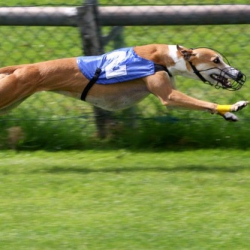Dog racing in the United States has entered a kind of twilight existence. The same brand of gambling which killed interest in the dog tracks is ironically the same reason such tracks still exist. While no one seems interesting in betting on greyhounds anymore, the tracks where the greyhounds race continue to operate a minimum number of days per year. State laws make dog days a requirement.
The story of greyhound tracks in the United States is complicated, full of its own share of ironies. The same business model which undermined the economic viability of racetracks has also extended the life of dog racing, into an economic limbo. Decisions made by politicians and businessmen have made it so, but so has the market economy. Here is the explanation of how.
How Casino Gambling Killed Dogtracks
Back in 1989, casino gambling was found in only two U.S. states: New Jersey and Nevada. Even 25 years ago, the only legal gambling within driving distance of most Americans were the regional horse tracks and dog tracks. When no rivals in the area, dog racing had a viable existence, even if it didn’t have the glamor of thoroughbred horse racing.
Here in 2014, casinos are found in nearly 40 US states, often in the form of Indian gaming casinos. The spread of land-based casino gambling across the United States has taken the allure out a trip to the greyhound races. Now, only 21 tracks regularly hold greyhound races in the USA. Of those, 12 are found in the state of Florida. Even at these venues, few customers show up for the racing events.
How Slot Machines Saved Dog Racing
One might wonder how these businesses continue to operate at all. They racecourses receive their profits from the racino activity which takes place at their complexes.
In the 1990’s, as casinos were being built by the dozens across the United States, lawmakers wanting to protect the local racing industry agreed to subsidize the tracks with gaming revenues. Some went even further, offering to license gaming machines and poker tables at the horse tracks and dog tracks of America. The gaming areas at the racetracks came to be called “racinos”.
State-Mandated Dog Races
To maintain their licenses, state legislatures stipulated in the laws that the operations had to host a certain number of racing days each year. Thus, the greyhounds race a certain number of days per year.
Isadore “Izzy” Havenick, whose family has owned Flagler Dog Track since 1953, says his venue’s 7,000-seat grandstand now holds a handful of visitors during the races. Izzy says, “On a good day we can have 100 people on the stands, and they are mostly smokers who come out from the casino floor.”
Betting Has Declined 75%
In 1990, the betting on the races was a $1 billion business for the state of Florida. Last year, the money wagered was only $258 million. When you consider the adjustment for inflation, the money wagered is less than 20% what it was less than 25 years ago.
Many track owners now wait for the day they can close their racing facilities and focus solely on the gaming tables and machines. Owners of the “ghost tracks“, where simulcast racing is now offered, hope for the same. Powerful casino interests exist in states where the casinos have appeared.
Those interests don’t want direct competition, so they are less likely to support a bill that would create more and better competition. Casino interests control big money, with the requisite ability to fund candidacies. These casino interests see political donations as the cost of doing business. Like any set of businessmen, they tend to be more concerned about their enterprise than the industry as a whole. When politicians discuss expansions of gambling which involve competitors, such as the dogtracks, these businessmen tend to balk at the notion. So the cycle continues, year after year.

